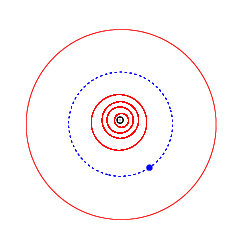9916 Kibirev
|
| |||||||||||||
| Discovery | |||||||||||||
|---|---|---|---|---|---|---|---|---|---|---|---|---|---|
| Discovered by | N. S. Chernykh | ||||||||||||
| Discovery date | 3 October 1978 | ||||||||||||
| Designations | |||||||||||||
| MPC designation | 9916 Kibirev | ||||||||||||
| 1978 TR2, 1983 VL1 | |||||||||||||
| Orbital characteristics[1] | |||||||||||||
| Epoch 13 January 2016 (JD 2457400.5) | |||||||||||||
| Uncertainty parameter 0 | |||||||||||||
| Observation arc | 15304 days (41.90 yr) | ||||||||||||
| Aphelion | 3.0944627 AU (462.92503 Gm) | ||||||||||||
| Perihelion | 2.6050478 AU (389.70960 Gm) | ||||||||||||
| 2.8497553 AU (426.31732 Gm) | |||||||||||||
| Eccentricity | 0.0858696 | ||||||||||||
| 4.81 yr (1757.2 d) | |||||||||||||
| 279.0619° | |||||||||||||
| 0° 12m 17.556s / day | |||||||||||||
| Inclination | 1.017838° | ||||||||||||
| 288.22130° | |||||||||||||
| 79.54806° | |||||||||||||
| Earth MOID | 1.6021 AU (239.67 Gm) | ||||||||||||
| Jupiter MOID | 2.33059 AU (348.651 Gm) | ||||||||||||
| Jupiter Tisserand parameter | 3.300 | ||||||||||||
| Physical characteristics | |||||||||||||
| 15.1714 h (0.63214 d) | |||||||||||||
| |||||||||||||
| 13.1 | |||||||||||||
|
| |||||||||||||
9916 Kibirev is a main belt asteroid. It orbits the Sun once every 4.82 years.[1] It is associated with the Koronis family of asteroids.[2]
Discovered on October 3, 1978 by Nikolai Chernykh at the Crimean Astrophysical Observatory, it was given the provisional designation "1978 TR2". It was later renamed "Kibirev" after Sergej Kibirev, a producer of microelectronics from Novosibirsk.[3]
References
- 1 2 "9916 Kibirev (1978 TR2)". JPL Small-Body Database. NASA/Jet Propulsion Laboratory. Retrieved 13 April 2016.
- ↑ Zappalà, Vincenzo; Bendjoya, Philippe; Cellino, Alberto; Farinella, Paolo; Froeschlé, Claude (1997). "Asteroid Dynamical Families.". EAR-A-5-DDR-FAMILY-V4.1. NASA Planetary Data System.
- ↑ MPC 42359 Minor Planet Center
External links
This article is issued from Wikipedia - version of the 9/10/2016. The text is available under the Creative Commons Attribution/Share Alike but additional terms may apply for the media files.
